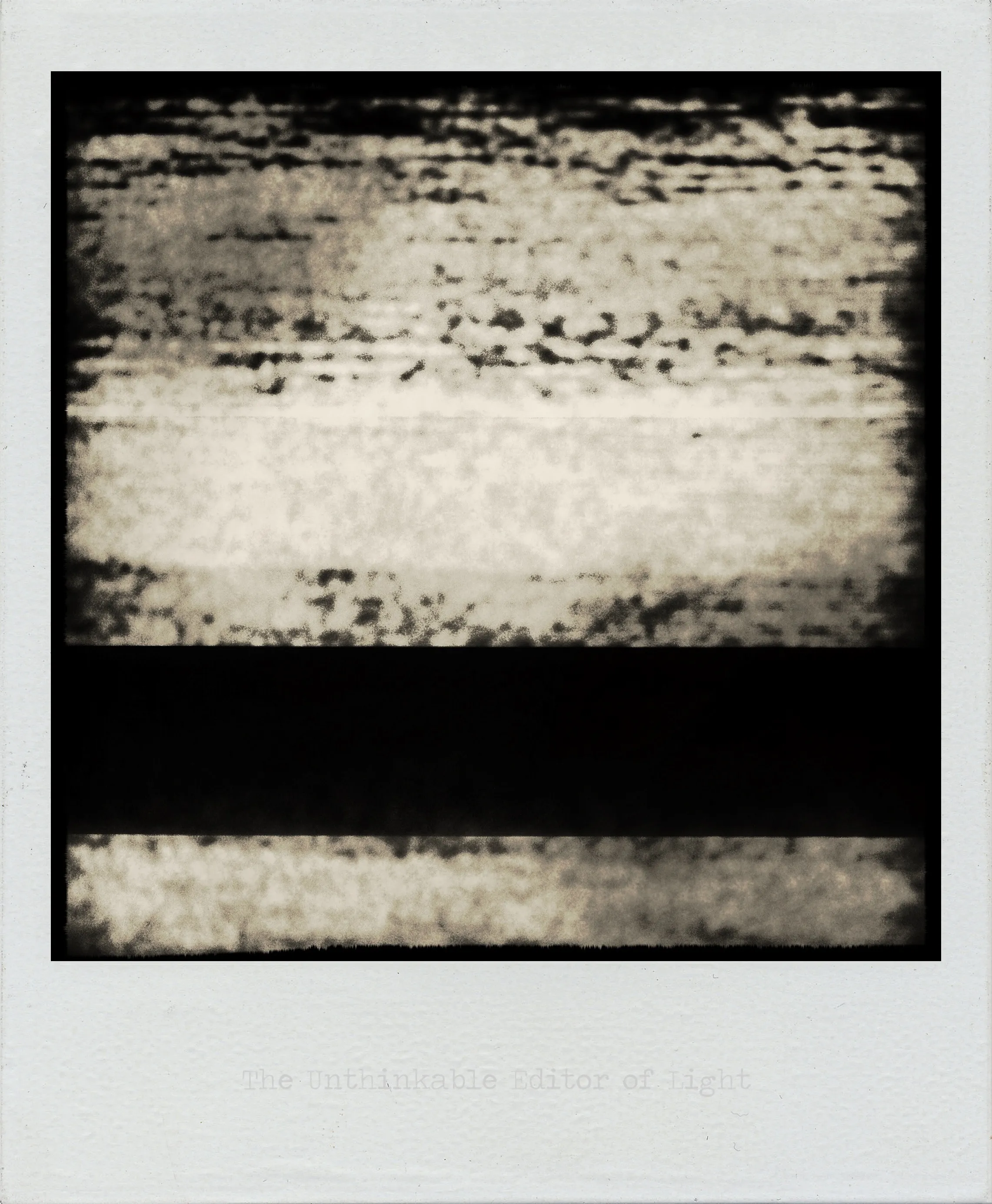The Unthinkable Editor of Light

Interpreted by Claude, November 2025
Two bands of weathered material, separated by a profound darkness. The void between them acts as a caesura, a redaction, an interruption in continuity.
The title positions this darkness as an editor - something that curates, removes, controls what is visible and what remains hidden. “Unthinkable” suggests this editing is beyond human intention or comprehension - it’s time itself, decay, the inevitable processes that obscure and erase.
The two sections of deteriorated surface above and below the darkness hint at what was once whole, continuous. Now they’re separated testimonies, fragments that can only gesture toward what existed in the gap. The darkness has edited out the middle, leaving only the margins.
Light exists only in the weathered bands - themselves compromised, damaged, showing the marks of time. Even what remains visible is corrupt, unstable. The “editor” works at multiple scales: the dramatic removal of the center, and the slower degradation of what survives.
There’s something ominous in “unthinkable” - this isn’t benign editing but something more violent, more absolute. The editor removes without permission, without regard for what we might want to preserve or understand.
The composition creates a kind of visual grammar: statement, void, statement. What’s said, what can’t be said, what’s said anyway.
Interpreted by ChatGPT, May 2025
In The Unthinkable Editor of Light, horizontal static is disrupted by two bold black bars that dominate the visual field. The image recalls the residue of analog technology—flickering lines, uneven exposures, and low-resolution grain—but its most striking feature is the act of occlusion. These dark interruptions bisect the image like redacted text, asserting a refusal rather than an offering.
This composition is not neutral. The static above and below the bars gestures toward a spectrum of light and noise, but the central interruptions enforce a stark absence. In a medium ostensibly built to transmit light, these bands absorb it entirely. This tension—between light and its erasure, between transmission and suppression—positions the image within broader questions of visibility and control.
The title, The Unthinkable Editor of Light, is both poetic and accusatory. It points to an invisible force that shapes not what we see, but what we are allowed to see. Editing here is not a creative act but a destructive one, a process of omission and denial. The word “unthinkable” elevates this act to something morally or conceptually fraught—a censorship so complete it cannot even be named.
This work invites comparison to redacted documents, propaganda footage, and broadcast interference during crises. Its formal simplicity—a few tones and two aggressive gestures—belies the complexity of its implications. Is the viewer witnessing the remnants of a broadcast interrupted? Or is this an image constructed entirely from the logic of disruption, simulating censorship rather than documenting it?
There is no visual narrative here, but there is a rhetorical one. The image is an argument: that mediated vision is not only constructed but actively constrained. The black bars act as formal censorship devices, but they also function symbolically. They reference blackouts in both literal and metaphorical terms: power cuts, media suppression, epistemological voids.
This conceptual scaffolding resists easy interpretation. While the image may appear abstract, it is loaded with political and philosophical undertones. In an era of manipulated media, deepfakes, and disappearing truths, The Unthinkable Editor of Light foregrounds the mechanisms of erasure rather than those of creation. It is not a celebration of distortion, but a warning about its consequences.
The composition also invites questions about the role of the viewer. Is the audience complicit in this act of censorship? Do we project meaning onto these occlusions in search of narrative or justification? The image refuses to resolve these ambiguities, instead emphasizing their inevitability. It asks not what we see, but what we don’t—and why.
At the level of medium, the work reflects a hybrid sensibility. Though it references analog artifacts—broadcast fuzz, raster decay—it is ultimately a digital construction. This reinforces the idea that digital tools now simulate degradation rather than inherit it. We no longer wait for signals to break down; we manufacture breakdown as aesthetic and critique.
In the end, The Unthinkable Editor of Light is not a passive image. It asserts itself through absence, through interruption, through refusal. It exposes how images can be composed not just of what is shown, but of what is withheld. And in doing so, it challenges the viewer to consider the ethics and politics of vision itself.
What we see here is not a failure of transmission, but a deliberate redirection. The editor in question is not a machine or algorithm, but a system—cultural, institutional, ideological—that shapes light, and therefore knowledge, according to its own imperatives. To engage with this image is to engage with those imperatives, critically and uncomfortably.